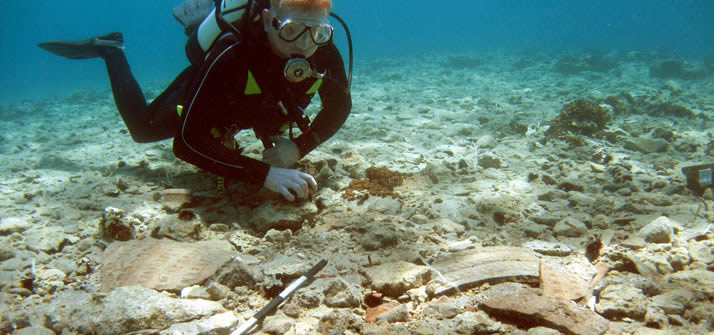
2010 Season
Diver over a spread of sherds from a Bronze Age storage jar
From 31st May to 26th June 2010 we completed the detailed digital survey of the site, recording 40,000 square metres of previously known buildings as well as over 10,000 square metres of new buildings which were discovered this year. In addition artefactual material from across the site was lifted, according to a virtual grid, in areas that will be selected for excavation in 2011. Important discoveries in the new areas of buildings included roof tiles, street gutters and large intact storage vessels. The finds recovered so far confirm the Mycenaean occupation of the site but also reveal occupation as early as 3,500 BC making Pavlopetri, at over 5,000 years old, the oldest known submerged town in world.
As well as ensuring the continuation of the project, money donated from a private sponsor enabled a team from the Australian Centre for Field Robotics (ACFR) to bring cutting edge stereo-photogrammetric equipment which combine stereo photo-realistic imagery with millimetre accurate three dimensional models of underwater surfaces and features. The results of this work were amazing – we managed to record over half of the site at 1:1 and we are now working through the data to produce photo-
Recording the site in 2010 using the
stereo-photogrammetric diver rig
realistic three dimensional models of the site. This was the first time such equipment had been used on a submerged settlement and the data gathered so far suggests it has the potential to completely revolutionise the practice of underwater archaeological survey.
Alongside the detailed digital survey of the site, oceanographic research was carried out by the Hellenic Centre for Maritime Research to reconstruct the ancient shoreline and the geomorphology of the seabed between Elaphonisos and Viglafia. A major aim of the 2010 season was to identify how and when the site became submerged and the data gathered this year will be analysed over the coming months to attempt to answer this question. At this stage it seems that the site was submerged in three or four separate earthquake events – the first
Working on the digital stereo-photogrammetric data
sometime after 1000 BC and the final event prior to 1700 AD.
The project was filmed by the BBC and Discovery Channel this year and will be shown as a major one hour documentary in 2012.
The Hellenic Centre for Maritime Research research vessel
survyeing the seabed around the site in 2010